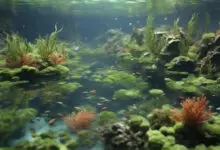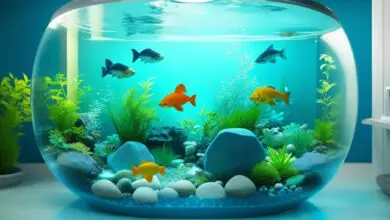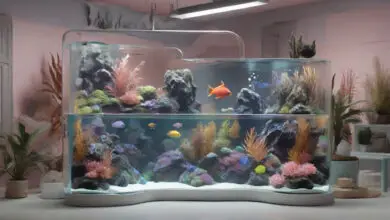Balancing Beauty and Health in Planted Aquariums

Aqua scaping creates stunning underwater art using live plants, stones, driftwood and more. It makes amazing tank displays that feel like natural ponds or rivers. But all the decorations make cleaning harder over time. So aquascapers must balance beauty and fish health.
This involves careful design choices and gear picks first. Then keep up on tank maintenance without wrecking the hardscape garden layout every few weeks. Use science to optimize natural looks and ecology together for easier long-term success.
How Aquascapes Get Messy
Beautiful aquascapes use layered plants, fertilized soil, and solid hardscapes. This allows creating depth and texture like above water gardens have. But the decor and plant shedding also traps more dirt than bare tanks normally would.
Decomposing plant matter along with fish waste collects everywhere in planted setups. Leaves, stems, roots and uneaten food hide among dense decorative elements to rot slowly. Hard to reach spots under wood or behind rocks gather gunk that keeps piling up more over time.
Tanks looks messier faster despite bigger filters running. The extra debris outcompetes processing capacity as it builds up. Filter flow also reduces passing all these solids until it chokes.
Without control, excess waste smothers plant roots, spikes ammonia and nitric acid levels, and blocks available light penetration. Algae outbreaks follow directly from organic pollution taking over an aquascape. Then the entire layout crashes affecting fish health negatively.
Science Behind Imbalances
Several biological processes interact causing aquascaped tanks to degrade faster without intervention. Understanding these helps create layouts balancing beauty with stability better. Good design prevents organics accumulating beyond system processing capacity.
Excess Nutrients
Aquasoil contains nitrogen, phosphates, potassium and micronutrients feeding plants. Fish waste and decaying plant matter add more nutrients to this same water daily. Too many nutrients overload biological transformations causing nuisance algae blooms instead. This further chokes plants as algae blocks their light access.
Green dust types especially coat plant leaves struggling then to photosynthesize optimally. Diatoms turn tank walls ugly brown next preventing owners enjoying their own hard work any longer.
Poor Circulation
Filters must turnover 10 tank volumes daily minimum to prevent buildups. Powerheads help hit these targets in large aquascaped systems. But intricate hardscapes easily block free flow needed reaching through crevices around each decoration.
Zones with poor circulation then accumulate sediment and debris in place steadily. Anaerobic gas pockets emit from these deadspots harming plant roots or invertebrates trying to clear waste but simply dying off themselves.
Limited Mechanical Filtration
Plants supplement biological filtration capabilities but remain ineffective removing larger solid particles alone. External filters with floss media polish water mechanically trapping particulates before recycling cleaner water again.
Tanks missing this stage of filtration allow slipping by wood bits, uneaten flakes, leaf litter and other large organic pieces. These quickly overload biological capacity processing such concentrated buildup then choking flows. White mold and fungus feed everywhere without mechanical prefiltration.
Keys to Self-Sustaining Aquascape Equilibrium
Beautiful aquascapes take work balancing increased decorative waste accumulation rates against stability. But several keys make sustaining elaborate layouts much easier long term. Good design prevents perpetual algae and detritus cleanup frustration.
Rule of Thirds Aquascaping
Properly arranging tank space using the artistic “rule of thirds” applies to aquascapes too. This style places key hardscape elements off-center while creating visible lines of sight across multiple lower, mid and upper levels. Follow principles making any photography composition interesting and tanks gain dimension with cleaner lines of flow and debris passage possible top to bottom.
Dense Plant Grouping
Filling in gaps between hardscapes with plants avoids open zones where film coats and deadspots hide without water motion. Directing some output tubes toward walls helps but dense foliage everywhere combats this more completely. Group midground plants in uneven clusters not straight lines for natural flow round. Encase hardscape cracks wholly with carpeting plants preventing unseen gunk trapping too.
Filter Overcapacity
Assume filters moving 10 tank volumes hourly will slow over 6 months as plants grow denser and debris accumulates inscape unevenness inevitable. Bigger filters still allow declining to 10 turnovers later, avoiding issues at 6 month minimal cleaning stages. Give capacity headroom accepting some unavoidable flow losses from aquascape intricacy emerging over time. Upgrade as needed.
Necessary Aquascaping Maintenance
Even ideal aquascape plans require some regular cleaning uniquely. Natural layouts need special tools navigating tightly around decor without destroying ecological balance growing. Work delicately to sustain both hardscape beauty and living stability longer term.
Targeted Water Changes
Use turkey basters sucking mulm selectively from front visible spaces between plants instead of pulling roots up. Lean stems aside gently where clustered hiding lower zones needing targeting waste removal too. Water changes eventually require siphon vacuuming also but minimalize root disturbances with precise directional extraction between thick clusters. Remove only what is seen clogging paths or sprouting new blanket algae before it spreads across full leaf surfaces out of control covering everything. Avoid ripping up stability support bushes because of minor debris visible central spaces. Careful precision keeps balance best ongoing.
Filter Cleaning Without Bacteria Loss
Maintain filters regularly before flow drops below 50% to sustain turnover reaching hidden backwall spots still where plants scarcely grow density yet over their first year. But retain original filter media after rinsing mechanical pads clean instead of replacing cartridges new.established beneficial bacterial no longer need floss pads once their slime populations coat all media surfaces fully maturing tanks months into startup. Swap floss only, returning all media always minimizes losses avoiding new tank cycles if turned too clean. Allow some grunge remaining or drying out kills off what took months establishing originally.
Spot Algae Removal Early
Remove new sprouting algae clumps using hands or cotton swabs gently scrubbing leaves clean individually before dense coats expand covering everything quickly. Tweezer out strands from among mosses and stems early on before it mixes into a mess also uprooting the slow growing plants when sheets grab on too strong overtaking whole zones. Early gentle intervention keeps problems localized. Stay on top of densities when first observable instead of waiting until no longer possible.
Careful hands on precision gives aquascapes the routine care needed avoiding full trimming destruction every few months from decline. Work delicately, selectively improving flow and declining zones piece by piece to sustain balance at higher ranks of beauty. Keep hands wet and movements slow protecting stability that took months establishing from harm when chasing visible debris insatiable. Ongoing minor efforts prevent whole system failures and fish losses utilizing natural filtering powers growing fuller each day.







